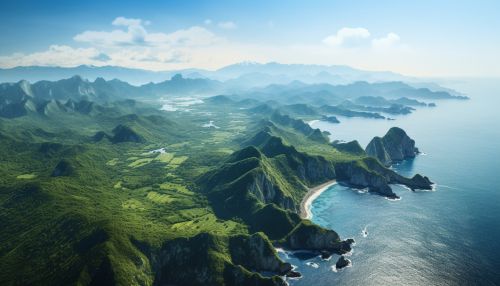Liaodong Peninsula
Geography
The Liaodong Peninsula is a significant geographical feature located in the southernmost part of Liaoning Province in Northeast China. This peninsula juts out into the Yellow Sea, dividing it into the Bohai Sea to the west and Korea Bay to the east. It is approximately 400 kilometers long and varies between 100 to 200 kilometers wide. The peninsula's terrain is characterized by rolling hills, plains, and mountains, with the Changbai Mountains forming its northern boundary.


History
The history of the Liaodong Peninsula is marked by a series of significant events, including invasions, wars, and territorial disputes. The peninsula's strategic location has made it a coveted territory for various powers throughout history. The earliest known inhabitants of the peninsula were the Dongyi people, who were later displaced by the Han Chinese during the Qin Dynasty.
The peninsula was the site of the First Sino-Japanese War (1894-1895), which ended with the Treaty of Shimonoseki. This treaty initially ceded the peninsula to Japan, but international pressure, particularly from Russia, Germany, and France, led to the return of the territory to China. This event, known as the Triple Intervention, significantly influenced the geopolitical dynamics of East Asia.
Economy
The economy of the Liaodong Peninsula is diverse, with significant contributions from various sectors. The peninsula's rich mineral resources, including iron, coal, magnesite, and diamonds, have made it a hub for mining activities. The region is also known for its heavy industries, particularly in cities like Anshan and Dalian, which are known for their steel production and shipbuilding industries, respectively.
Agriculture also plays a crucial role in the peninsula's economy. The region's fertile soil and favorable climate conditions make it suitable for growing a variety of crops, including rice, wheat, and soybeans. The peninsula's extensive coastline also supports a thriving fishing industry.
Culture
The culture of the Liaodong Peninsula is a blend of traditional Chinese culture and influences from the various ethnic groups that have inhabited the region throughout history. This cultural diversity is reflected in the peninsula's art, music, cuisine, and festivals.
One of the most notable cultural features of the peninsula is its folk art, particularly the Liaodong Papercutting, which is recognized as a national intangible cultural heritage in China. The region is also known for its traditional music, such as the Errenzhuan, a form of folk opera popular in Northeast China.
Flora and Fauna
The Liaodong Peninsula is home to a diverse range of flora and fauna. The region's varied terrain and climate conditions support a wide variety of ecosystems, from coastal wetlands to mountain forests. The peninsula is known for its bird diversity, serving as a crucial stopover point for migratory birds along the East Asian-Australasian Flyway.
The peninsula's forests are dominated by deciduous species such as oak, birch, and maple. The region's coastal areas support a variety of marine life, including several species of fish, shellfish, and seaweed.


